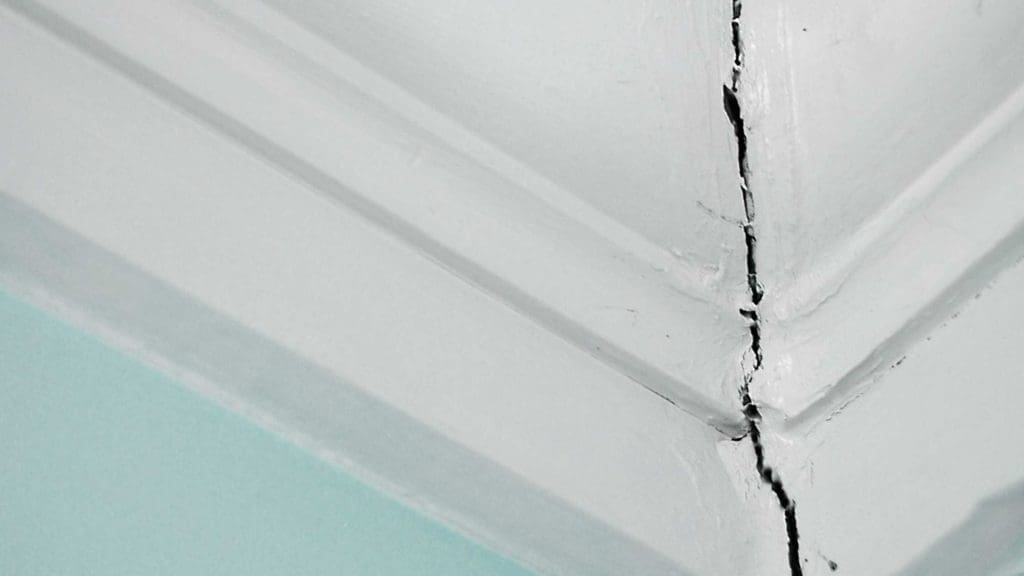When it comes to your walls, a crack is a crack, right?
Yes and no.
Some cracks are superficial. They might be caused by simple maintenance issues that are easy to fix. In some cases, you can be doing everything right and still get one of these cracks. There’s no reason to worry about them, but you might want to get them fixed for aesthetic reasons.
Then there’s the other kind.
While the great majority of cracks in your wall are no big deal, some deserve to be paid attention to. These cracks are serious because they indicate alarming problems throughout the structure of your house. In the most severe cases, they are evidence of evolving deterioration within your foundation.
Your foundation is one of the most important parts of your home. It exists to spread out the structure’s enormous bulk – which weighs in at several tons – and prevent it from sinking into the ground. Yet, despite its efforts, any home will “settle” on its foundation over the course of its life.
This settling is normal. Sometimes, you can even hear creaking as it happens.
Yes, some cracks are caused by this ordinary and unavoidable process. But a small minority of cracks are symptoms of damage to a home’s foundation that should be fixed right away. Unfortunately, it’s not always easy for homeowners to tell the difference.
You shouldn’t hesitate to call a Houston foundation repair company if you are concerned about your foundation. Of course, many people in Houston make the call when they notice cracks in the foundation itself. But you can also learn a lot from what you see on your walls.
Let’s take a closer look at the different types of cracks in your wall and what they might mean.
Wall Cracks that Indicate Harmless Settling
1. Vertical Cracks
Vertical cracks, those that run “up and down” in your interior walls, are often nothing to worry about. They are commonly caused by house settling and don’t point to anything worse. In addition, because they run in the same direction as drywall, they are less troublesome to repair than horizontally oriented cracks.
2. Door and Window Cracks
Door and window cracks are much more likely to appear in older structures. They don’t signify damage on their own, but it’s important to take a close look. If these cracks appear at the same time the doors and windows become warped and harder to close, it may be time for a foundation inspection.
3. Spiderweb Cracks
Spiderweb cracks are extremely common in drywall and nothing to be concerned over. This just means that the drywall application is a little bit thick in one area. Because drywall tends to shrink as it dries up, cracks appear when the thickest coverage area recedes.
4. Nail Popping
Nail popping is noticeable in circular bumps or cracks that appear within the wall or ceiling. As the name suggests, it means nails have become unseated. Wood shrinkage causes a normal amount of nail popping in newer homes within the first two years after construction is finished.
However, there is a caveat. If you notice new nail popping taking place in an older home – ten years or more after construction – it may be time to go on alert. Late nail popping combined with other cracks in the walls, floors, or ceiling can be regarded as a red flag. So call the experts as soon as possible.
Wall Cracks that Indicate Foundation Problems
1. Horizontal Cracks
Horizontal cracks are any cracks that travel from left to right in an interior wall. They’re often situated so as to pass underneath windows. Whether seen in drywall or concrete, they are strongly associated with foundation woes. Water damage and poor soil below the foundation are two likely culprits.
2. Bowed Ceiling Cracks
When there’s a noticeable dip in one part of the ceiling compared to the rest, we call it a bowed ceiling. This always needs to be remedied, even if cracks haven’t appeared yet. It can be caused by an extremely heavy object on the floor above, construction issues with the ceiling, or foundation degradation.
3. Stair-Step Cracks
Stair-step cracks are regarded as one of the most prominent signs of foundation wear. These cracks will often appear early on when foundation damage is already significant but can be readily resolved with help. They emerge near windows and doors and can also pop up within hallways.
If you have stair-step cracks, it’s critical to talk to a Houston foundation repair company as soon as you can. It is usually only a matter of time before the more onerous signs of foundation weathering crop up. Unfortunately, the more time passes, the more complicated your foundation repair can get!
Contact us to find out more or get started with Houston foundation repair.

